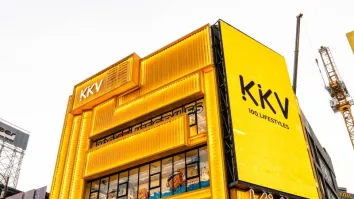
Riding the ‘mega-trends': Michael Cheng talks about business survival and the future of retail
For PwC’s Asia Pacific, Mainland China and Hong Kong Consumer Markets Leader, the future of consumption will combine online and offline features for a seamless, omnichannel shopping experience.
Michael has been PwC’s Asia Pacific, Mainland China and Hong Kong Consumer Markets Leader since 2013. Before that, he was PwC Hong Kong’s Consumer Markets Leader for over 5 years. He is responsible for coordinating practice strategy and service delivery for companies in the Consumer Markets sector in Hong Kong, Mainland China, and the Asia Pacific region.
With almost 35 years of professional assurance experience in Hong Kong and the United Kingdom (UK), he has developed a strong passion in the consumer's market sector specialising in IPO advisory, business and due diligence reviews, asset injections, and M&A activities in Mainland China and Hong Kong.
As one of the judges of Retail Asia Awards 2021, Michael shared some of his insights about the growth of e-commerce in Hong Kong; how retailers can survive after the pandemic; finding the right balance between running a business and adapting to future growth, and why choosing the winners this year was a tough one.
With the pandemic happening in Hong Kong, what would be the service delivery strategy that you would advise companies in the consumer market industry?
The pandemic has, to a large extent, catalysed the growth of e-commerce in Hong Kong as we have seen an upsurge of online shopping activities among Hong Kong consumers over the past sixteen months. Homebound and work-from-home individuals have resorted to online channels to meet their various needs from stocking up groceries and home office supplies, to receiving online education and entertainment.
Hong Kong's e-commerce market has just taken off from a relatively low baseline and is expected to maintain its momentum after the pandemic, benefiting from the fundamental changes in consumer demand and habits, the emergence of new online shopping platforms, increased digitalisation of retailers, and development of digital payment options.
It is fair to say that online shopping in Hong Kong is gradually gaining traction as major brands and shopping platforms are expanding their e-commerce footprints. However, we should not overlook the importance and resilience of bricks-and-mortar shops. They are well-positioned to rebound strongly on retail sales recovery, easing of travel bans and other restriction measures in the coming months, as COVID-19 cases continue to fall.
The future of consumption in the post-pandemic era will likely take on a new form, combining the features of both online and offline settings to offer a seamless, unified omnichannel experience for shoppers.
Looking forward, physical stores in Hong Kong will need to provide consumers with experiences and interactions to stay relevant, as opposed to selling products alone. Brands that will survive the post-pandemic environment will be those with a robust online presence and relevant physical setups that revolve around experience. As the online and offline worlds converge, consumers expect, more than ever, to obtain products and services at any time and any place.
What are the most important consumer market and retail industry trends that will dominate Asia Pacific, Mainland China, and Hong Kong?
Asia Pacific, including Mainland China and Hong Kong, is home to a robust base of consumers who have shown resilience amid strong economic recovery after the pandemic. Looking forward, we expect several mega-trends in the broader consumer landscape to play a key role in determining where and how the next dollar of the average consumer will be spent.
The store of the future
The store of the future will be omnichannel, experience-rich and will fuse the physical and digital worlds. Technology will continue to revolutionise online and physical retail, forcing rapid change and innovation. Retail consumers will expect frictionless, tech-enabled experiences. Traditional marketing channels will continue to blur as retailers and manufacturers embrace a direct-to-consumer model. The fulfilment experience will become an increasingly critical execution point. Health and safety concerns will linger for retail.
Brand relevance
Socially conscious consumerism will continue to grow as people seek brands that they trust and align with their values. Consumers keep raising their expectations for the brands they engage with. They will continue to seek purpose-driven brands that are responsive to an array of environmental, social and governance (ESG) concerns. Brands will have to articulate meaningful value propositions to win customers. The world of social media will increasingly influence brand perception and reputation.
Digital supply chain
The supply chain of the future will operate with near autonomy, making ‘smart’ decisions to self-regulate. Rapidly changing consumer expectations and behaviours are forcing supply chains to be more responsive and transparent. Trends, such as omnichannel shopping, multiple fulfilment points and geopolitical issues, will add to supply chain challenges. End-to-end visibility will be the number one requirement for effective supply chain management. Digital enablement of the sales journey will be key in evolving the supply chain.
With retail sales in Asia Pacific, Mainland China and Hong Kong currently struggling, and consumer spending on the decline, how can retailers survive--and even flourish—during the pandemic?
To transform quickly, retailers must identify and rapidly implement the changes that will provide the best chance of long-term growth. Making systemic changes will help companies develop the resilience needed to deal with shocks that lie ahead, and will build the management muscles that promote agility and innovation.
Smooth out price oscillations as much as possible. The pandemic has played havoc with supply chains and spiked prices. The volatility couldn’t come at a worse time; some consumers worldwide may have experienced a loss of income and higher household bills. The challenge is to use the many supply chain forecasting and price optimisation tools offered to minimise the price hikes as much as possible. Shoppers are likely to recognise and trust the businesses that show they’re doing a better job of consistently holding down prices.
Help shoppers feel safe. We’ve seen that customers will select experiences that reinforce safety. For example, prospective guests at hotels, restaurants, and entertainment venues will demand to know about cleaning protocols. As a result, many hospitality venues now publicly state how long their rooms are left vacant between occupancies. Multiple retailers are requiring their employees and customers to wear masks in-store, even when there is no government regulation dictating it. Customers can also request contact-free delivery.
Do more to blend physical and digital experiences. Consumers still value physical locations for the sensory and social experiences they offer. In PwC’s 2021 Global Consumer Insights Survey, despite the impact of COVID-19, 42 percent of global shoppers (50% in Mainland China; 62% in Hong Kong) of respondents said in-store shopping remains consumers’ channel of choice for daily or weekly shopping. And consumers are willing to pay higher premiums for emotional connections. Although digital channels now offer the routes of least resistance — especially in times of social distancing and lockdowns — human interaction is still very important, especially in explaining products or services and finding the right solutions.
Prioritise what customers say they care about. Companies must transcend price, quality, and availability by prioritising the intangibles that consumers care deeply about. Shoppers increasingly expect businesses to make sustainable, ethical choices that recognise stakeholders as much as shareholders, and that expectation has only increased since the onset of the pandemic.
How has digital disruption changed the retail industry and consumer markets sector?
Across most product categories, we’re also seeing that around the world, even in places where pandemic restrictions were lifted when the survey was a greater number of people say they’ve been shopping more or exclusively online compared to shopping more or exclusively in-store. Also, consumers are making their online shopping priorities clear - emphasising a need for fast and reliable delivery.
Online engagement extends to social networks. More than half of global consumers say they interact with the top four digital platforms, and more than one-third of those respondents, on average, say they’re actively clicking on advertising, revealing an opportunity for brands and retailers to explore their digital marketing spend.
Tackling imminent challenges under COVID-19 would call for a major shift in retailers’ operating strategies, towards e-commerce and O2O integration as well as more timely and targeted government support to aid the structural transformation of the retail industry as a whole. Traditional retailers should rebalance their portfolio and strengthen their capabilities in cross-border-e-commerce, to serve overseas markets and customers and diversify their geographical exposure. Retailers should explore areas of opportunity in portfolio realignment to enhance digital capabilities or value chain digitisation to improve efficiency.
How can retailers find the right balance between driving their current business and adapting themselves for future growth?
Driving current business and investing for future growth are not necessarily mutually exclusive. As the pandemic continues to accelerate the adoption of e-commerce, the recent success of local online platforms has presented a good learning opportunity for traditional consumer companies, in terms of expanding current business and getting prepared for the future. Faced with digitally-savvy consumers and a more tech-enabled landscape, retailers will surely benefit from adopting a more internet-based mindset when formulating their strategies.
Online and offline business models each have their own merits. There is no one-size-fits-all approach. Rather, as consumption scenarios become more proliferated, we should see the convergence of physical and virtual aspects of New Retail across a wide range of goods and services, that deliver the best customer experience for future growth.
What are your thoughts about this year's competitive entries for the Retail Asia Awards?
It was such an honour for me to be invited by Retail Asia as one of the judges for this year’s Store and Retailer categories, Project categories and CEO of the Year — particularly at a time of uncertainty that calls for innovative ideas and solutions to meet the present challenges.
Over the past sixteen years, the Awards programmes have earned public awareness and positive remarks in their effort in recognising excellent and innovative products and brands in the Asia Pacific region. This year will be no exception.
Choosing winners was tough as every participant excelled in different areas and ways. I would say the competition amongst the entries this year was very intense, making my role as a judge even more challenging. The shortlisted participants are from a diverse mix of industries spanning from cosmetics, jewellery, household goods to toys and games.
I truly enjoyed listening to the stories of a wide array of retail talent throughout Asia Pacific. Not only did they demonstrate high competency across the several basic attributes — achievements, challenges & solutions, innovation, and success & impact — I can see that some of the participating companies went the extra mile to come up with innovative product ideas to take advantage of emerging consumer trends.
I very much look forward to witnessing the winners of this year’s Awards and their real-life success in fulfilling their business aspirations and serving the greater good of society.



















 Advertise
Advertise





